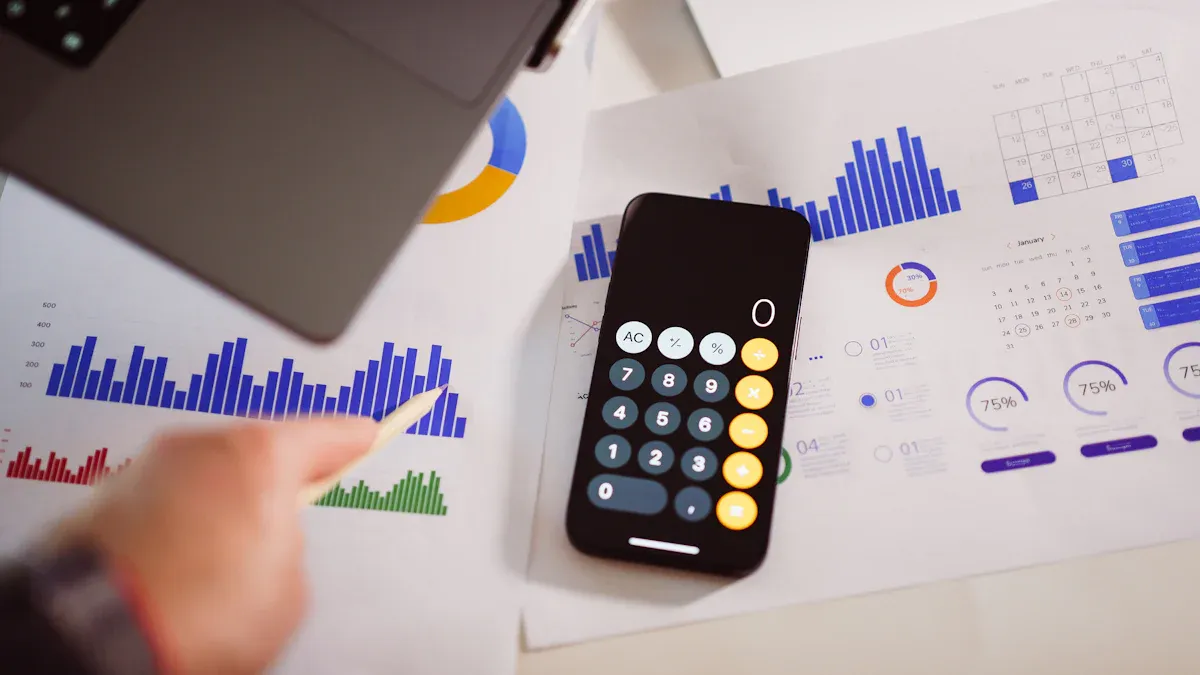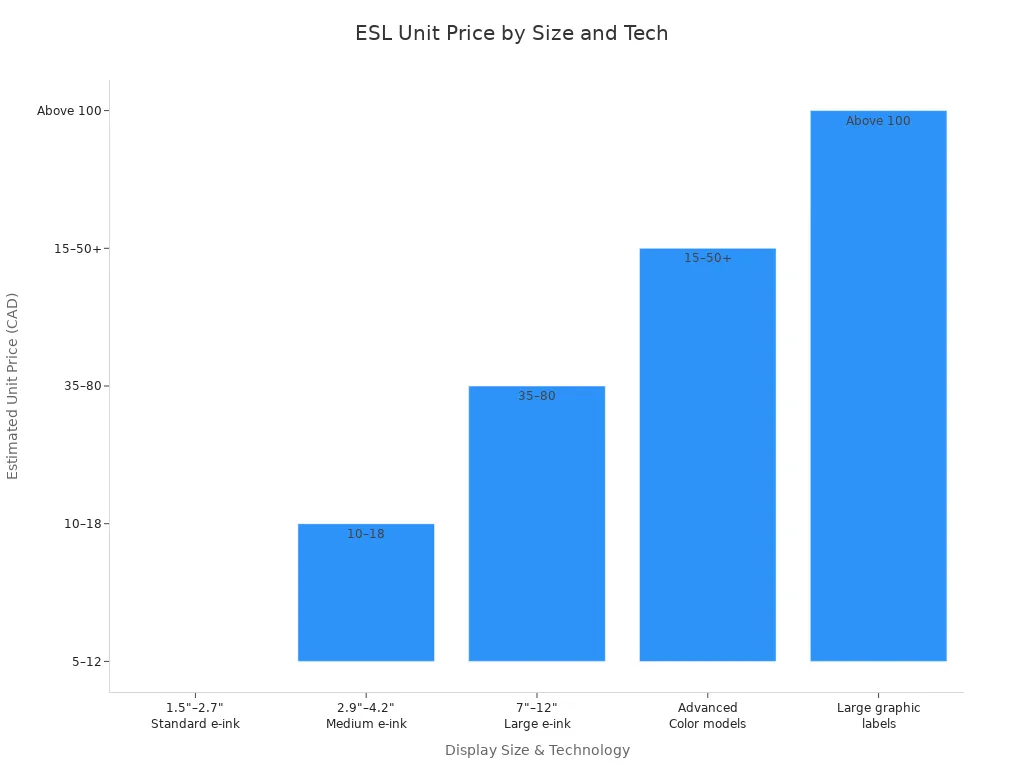
Switching to Electronic Shelf Labels introduces several main costs that you need to consider for your retail stores. You will face an initial start-up cost for each ESL Price Tag, plus expenses for the ESL Gateway AP and Esl Retail management systems. The average price per label depends on size, as shown below:
| Label Size Range | Price Range per Unit |
|---|---|
| 1.5-inch to 2.5-inch | $5 to $15 |
| 3-inch to 4.2-inch | $15 to $30 |
| 5-inch and above | $30 to over $100 |
Beyond hardware, your investment includes software, installation, and ongoing maintenance. Understanding the main costs helps you make informed decisions and maximize value.
Main Hardware Costs of Electronic Shelf Labels

Electronic Shelf Label Units and Price Ranges
When you evaluate the hardware investment for digital price tags, the unit price of each label forms the foundation of your total cost. The pricing for electronic shelf labels depends on several factors, including display size, technology type, and additional features. Smaller tags, typically between 1.5″ and 2.5″, cost between $5 and $15 per unit. Medium-sized labels, ranging from 3″ to 4.2″, usually fall within the $15 to $30 range. Larger labels, which can display graphics or promotional content, often exceed $100 per unit.
| Label Size | Price Range (per unit) |
|---|---|
| 1.5″ to 2.5″ | $5 to $15 |
| 3″ to 4.2″ | $15 to $30 |
| 5″ and above | $30 to over $100 |
You will find that the technology type also impacts pricing. Basic e-ink ESLs generally cost $10 to $30 per unit, while color e-ink and LCD models can reach $50 or more. Advanced features such as NFC, LED lighting, or waterproofing further increase the cost. Bulk purchasing can help you reduce the per-unit price, especially if you operate multiple stores or require a large number of digital price tags.

You should also consider that e-paper displays offer longer battery life and lower maintenance costs compared to LCD models. The initial pricing for basic models starts at $5, but advanced labels with color or graphic capabilities can push the cost well above $50 per unit. This range allows you to select the right balance between functionality and budget for your electronic shelf label system.
Gateways and Communication Devices Cost
To operate your electronic shelf label system, you need gateways or communication devices that transmit data between your management software and the digital price tags. The number of gateways required depends on your store’s square footage and layout. Each gateway typically covers several thousand square feet, similar to Wi-Fi access points. In large retail environments, you may need hundreds of gateways to ensure full coverage and reliable performance.
| Device Type | Average Cost Range | Additional Details |
|---|---|---|
| ESL Gateway | $300 – $400 | Transmits data to labels |
| Base Station (Gateway) | Around $150 | Controls ~1,000 price tags |
You should plan for the cost of these devices as part of your upfront investment. For example, a standard ESL gateway costs between $300 and $400, while a base station that manages about 1,000 price tags averages around $150. The total cost will scale with the size of your store and the number of digital price tags you deploy. You must also factor in installation and potential upgrades to your existing network infrastructure to support these devices.
Tip: When planning your deployment, map your store’s layout to determine the optimal number of gateways. This approach helps you avoid coverage gaps and unnecessary costs.
Factors Affecting Hardware Cost
Several factors influence the overall hardware cost of your electronic shelf label system. Understanding these variables helps you make informed decisions and optimize your investment:
- Store size and product count: Larger stores and higher product volumes require more digital price tags, increasing total costs.
- Label type and features: Basic LCD labels offer a lower upfront cost but fewer features. Graphic or color e-ink labels provide advanced capabilities, such as promotional displays or NFC, but come at a higher price.
- Display technology: E-paper displays consume less power and reduce maintenance costs, while LCD models may require more frequent battery replacements.
- Communication technology: Infrared systems cost more than radio-frequency options but offer benefits like faster updates and longer battery life.
- Integration and compatibility: If your current hardware or software needs upgrades to support the new system, you may face additional costs.
- Durability and installation: Labels designed for harsh environments or specialized fixtures can increase pricing. Easy-to-install models help reduce labor costs.
- Bulk purchasing and vendor selection: Buying in large quantities lowers the per-unit cost. Choosing a vendor with strong integration capabilities and transparent pricing helps you manage long-term costs.
You should also consider the impact of optional features, such as QR codes or LED indicators, which enhance customer experience but add to the hardware cost. Selecting the right mix of features and technology ensures you achieve the best value for your investment.
Software and Integration Cost
Management Software Licensing Fees
When you deploy an electronic shelf label system, you must budget for electronic shelf label software licensing fees. Most vendors offer management platforms that control digital pricing, real-time price updates, and inventory management system integration. These platforms often use a tiered pricing model based on store size, number of labels, and feature set. You may pay a one-time license fee or monthly subscription fees, which can range from $50 to $500 per store. The cost depends on whether you choose basic digital pricing solutions or advanced platforms with analytics, mobile access, and real-time pricing updates. You should review contract terms carefully to avoid hidden costs, such as charges for extra users or premium support.
Tip: Ask vendors for a clear breakdown of software costs, including updates and support, before signing any agreement.
Integration with Existing Retail Systems
Integrating electronic shelf label software with your current POS or inventory management system can add complexity and cost. Most modern ESL platforms support API connections for seamless data exchange, enabling real-time price updates and digital pricing across all shelves. This integration eliminates manual relabeling and reduces pricing errors. You may need middleware to bridge legacy systems, which increases upfront cost and requires skilled labor. Retailers often report a 60-90% reduction in price update time and up to 20% fewer human errors, leading to lower operational costs. However, you may face challenges with compatibility, data synchronization, and network robustness. To manage risk, consider starting with a pilot program and partnering with experienced teams to control investment and operational costs.
- Common integration challenges:
- Compatibility issues with outdated POS systems
- Data errors and operational disruptions
- High upfront cost for hardware, software, and labor
- Need for skilled technicians
Cloud vs. On-Premise Electronic Shelf Label Cost
You must decide between cloud-based and on-premise digital pricing solutions. Cloud ESL systems offer lower upfront cost, fast deployment, and automatic updates. You pay monthly subscription fees and data storage charges, which can increase total cost over time. On-premise systems require higher initial investment but may have lower recurring costs if your IT team manages maintenance. Security and compliance play a major role in this decision. Cloud solutions provide enterprise-grade security and scalability, while on-premise systems give you full control over data privacy and hardware. Hybrid models combine cloud scalability with on-premise security, reducing long-term compliance costs.
| Aspect | Cloud ESL Systems | On-Premise ESL Systems |
|---|---|---|
| Upfront Cost | Minimal upfront investment; pay-as-you-go model | Higher initial investment in hardware and setup |
| Maintenance Cost | Recurring subscription fees; vendor-managed updates | Internal IT resources needed for maintenance and upkeep |
| Security | Enterprise-grade security features; shared responsibility; regular updates | Full control over security; physical access control; no multi-tenant concerns |
| Performance | Dependent on internet connection; built-in redundancies | Direct hardware access; customizable; more consistent in unreliable internet areas |
| Scalability | Near-instant scaling; pay only for usage | Limited by physical hardware; requires planning |
| Control & Customization | Limited hardware customization; platform constraints | Complete control over hardware and software configurations |
| Compliance | Pre-certified environments; good for some regulations | Better for strict regulatory compliance needing tight control |
You should evaluate total cost of ownership, including maintenance, updates, security, support, scalability, and vendor lock-in risks, before choosing a solution for your electronic shelf label system.
Installation and Setup Cost
Professional Installation Services
When you choose professional installation for your electronic shelf label system, you gain access to expert technicians who handle the setup efficiently. The average cost for professional installation per store ranges from $1,000 to over $5,000. This cost depends on the complexity of your store and the number of ESL units you plan to deploy. The table below outlines typical installation expenses:
| Store Complexity | Installation Cost Range |
|---|---|
| Small/Basic Layout | $1,000 – $2,000 |
| Medium Complexity | $2,000 – $4,000 |
| Large/Complex Layout | $4,000 – $5,000+ |
Professional services often include mounting the labels, configuring gateways, and testing the system. You benefit from reduced downtime and fewer errors during setup, which can help you avoid unexpected cost overruns.
In-House vs. Outsourced Setup Cost
You may consider handling installation in-house to reduce the overall cost of implementation. However, in-house installation brings hidden costs and risks. Staff retraining, technology upgrades, and system integration can increase your expenses. You also face potential downtime and disruption during the process. Outsourcing to professionals may cost more upfront, but it often leads to smoother deployment and fewer long-term issues.
Note: In-house installation can lead to extra costs for staff training, IT support, and compliance. Outsourcing shifts these responsibilities to the vendor, which can help you control your total cost.
Impact of Store Size and Layout on Cost
Store size and layout play a major role in determining your installation cost. Larger stores require more ESL units and gateways, which increases both hardware and installation expenses. Complex layouts with many aisles or unique shelving may require custom solutions, raising the cost further. The number of labels, infrastructure needs, and maintenance requirements all contribute to the final cost of implementation.
- Factors that increase installation cost:
- Large floor area
- High product count
- Complex shelving or display arrangements
- Advanced network or power requirements
Careful planning and a detailed site survey help you estimate your installation cost accurately and avoid surprises.
Maintenance and Ongoing Electronic Shelf Label Cost
Battery Replacement and Lifespan Cost
You will find that battery replacement is one of the most predictable ongoing costs for electronic shelf labels. Most ESL batteries last between 5 and 10 years in typical retail environments. This long lifespan results from energy-efficient e-paper displays and low-energy wireless communication. If you update your labels about four times daily, you can expect batteries to last around five years. Factors such as update frequency, display complexity, and store temperature can affect battery life. Most ESLs use CR button cells, which are easy to replace. You should plan for battery replacement as a scheduled maintenance task rather than a frequent expense. By optimizing your update routines and choosing high-efficiency labels, you can reduce battery-related costs and avoid unexpected downtime.
Software Updates and Technical Support Fees
Ongoing software updates and technical support represent another important area of cost. Service level agreements (SLAs) often cover software updates, remote diagnostics, and uptime guarantees. These agreements help you control expenses by formalizing support expectations and providing proactive maintenance. SLAs may also include battery warranties, sometimes up to 10 years, which further reduce replacement costs. You benefit from central monitoring and regular business reviews, ensuring consistent service quality. By relying on structured support, you can better predict your technical support fees and avoid surprise expenses.
Tip: Review your SLA carefully to understand what services are included and how they impact your ongoing costs.
Regular System Checks and Upkeep Cost
Regular system checks and preventive upkeep help you maintain the reliability of your electronic shelf label system. You should schedule periodic inspections to verify label performance, gateway connectivity, and battery status. These routine checks allow you to identify issues early and minimize operational disruptions. While these activities add to your ongoing costs, they protect your investment and extend the lifespan of your hardware. By budgeting for regular maintenance, you can avoid larger repair expenses and ensure your ESL system continues to deliver value.
Hidden and Additional Main Costs
Training and Onboarding Expenses
When you switch to electronic shelf labels, you need to plan for training and onboarding costs. Training for manual price tagging often costs between $1,200 and $1,300 per employee. This includes trainer fees, materials, lost productivity, and administrative labor. Manual onboarding takes several hours per person and requires frequent retraining due to product changes or promotions. Poor onboarding can lead to higher turnover, which increases your overall cost.
With electronic shelf labels, you reduce training time to less than one hour per employee. This lowers labor costs and helps your team adapt faster. You can use in-person sessions, online modules, or video tutorials to support learning. AI-supported training and hands-on demonstrations also speed up adoption. Continuous support keeps your staff confident and reduces the need for retraining.
| Phase | Description | Duration |
|---|---|---|
| Kickoff Call | Confirm store info, review modules, schedule audit, define timeline | 1 hour |
| Site Readiness Audit | Verify installation readiness, cabling, internet, power, tag counts | 1-2 hours |
| Account Set-Up & Data Migration | Migrate product data, verify accuracy, provision account | Varies |
| Back-Office Training | Train store leadership on back-office features | 2 hours |
| Launch Day & Staff Training | Train staff on new system | Included in launch |
| Additional Training | Based on modules purchased | N/A |
Tip: Investing in quality training makes your transition smoother and protects your investment in new technology.
Warranty and Service Contract Cost
You should review warranty and service contract terms before finalizing your purchase. Most vendors offer standard warranties that cover hardware defects for a set period. Extended warranties and service contracts add to your upfront cost but can save you money on repairs and replacements. Service contracts may include technical support, software updates, and even battery replacement. These agreements help you control long-term costs and ensure your electronic shelf label system remains a worthwhile investment.
Compliance and Regulatory Fees
Compliance and regulatory fees can affect your total cost. You may need to meet local or national standards for electronic devices, data privacy, or wireless communication. Some regions require certification for radio-frequency equipment or specific labeling for consumer safety. You should budget for these fees as part of your overall investment. Staying compliant protects your business and makes your electronic shelf label system a worthwhile investment for the long term.
Comparing Electronic Shelf Label Cost to Traditional Price Tags

Upfront vs. Long-Term Cost Comparison
When you compare electronic shelf labels to traditional price tags, you notice a clear difference in upfront payment. The average cost per electronic shelf label ranges from $5 to $15, depending on the model and features. You also need to invest in management software, which can cost around $500, and gateways for communication, costing $300 to $400 each. This means your initial investment for digital pricing is substantial. In contrast, traditional paper price tags cost only a few cents per tag, with minimal annual printing expenses. For a full-store rollout, the one-time payment option for ESLs can reach thousands or even millions of dollars, depending on store size. However, the true cost of ownership becomes more apparent over time as you factor in ongoing labor, printing, and maintenance.
Labor and Time Savings with ESLs
You gain significant labor and time savings when you switch to digital pricing. ESLs automate pricing updates, reducing labor costs by up to 80%. Manual price updates are slow and prone to errors, while digital pricing changes are instant and accurate. For stores with large inventories and frequent price changes, ESLs improve operational efficiency and customer satisfaction. You eliminate recurring expenses for printing, paper, ink, and printer maintenance. The lifespan of ESLs can reach up to 10 years, requiring minimal maintenance. These efficiency gains compound over time, leading to substantial operational cost savings and a lower long-term cost compared to traditional price tags.
- Automated pricing updates reduce labor costs by up to 80%
- Manual price updates for large inventories can consume over 8 hours per cycle
- ESLs eliminate recurring printing and processing expenses
- Digital pricing reduces pricing errors and lost revenue
Potential ROI and Value for Retailers
You should consider the potential ROI when evaluating digital pricing. Many retailers see a return on investment within 2-3 years, especially those with frequent price changes or large inventories. ESLs provide long-term benefits by reducing labor costs, minimizing pricing errors, and improving operational efficiency. The true value of this technology lies in its ability to streamline store operations and enhance the customer experience. For most retailers, ESLs represent a worthwhile investment that delivers measurable ROI and supports future growth.
When you evaluate the main costs of switching to electronic shelf labels, you must consider hardware, software, installation, and ongoing maintenance. The main costs depend on store size, technology choices, and integration needs. You should review each electronic shelf label cost carefully before making a decision.
- Hardware and software form the largest expenses
- Installation and training add to your investment
- Ongoing maintenance ensures long-term value
Careful planning helps you maximize ROI and streamline store operations.
FAQ
What is the average lifespan of electronic shelf labels?
Most electronic shelf labels last between 5 and 10 years. Battery life depends on update frequency and store conditions. You can expect reliable performance with regular maintenance.
Can you reuse electronic shelf labels if you remodel your store?
Yes, you can relocate and reuse most electronic shelf labels. You may need to reconfigure gateways and update software settings to match your new layout.
Do electronic shelf labels work during power outages?
Electronic shelf labels with e-paper displays retain information during power outages. You will not lose pricing data. Updates resume automatically when power returns.
How often should you update the software for your ESL system?
You should schedule software updates at least once per quarter. Regular updates keep your system secure and add new features. Your vendor may offer automatic updates.
Are there any ongoing fees after the initial installation?
Yes, you may pay for software licenses, technical support, and battery replacements. Review your service contract to understand all recurring costs.


